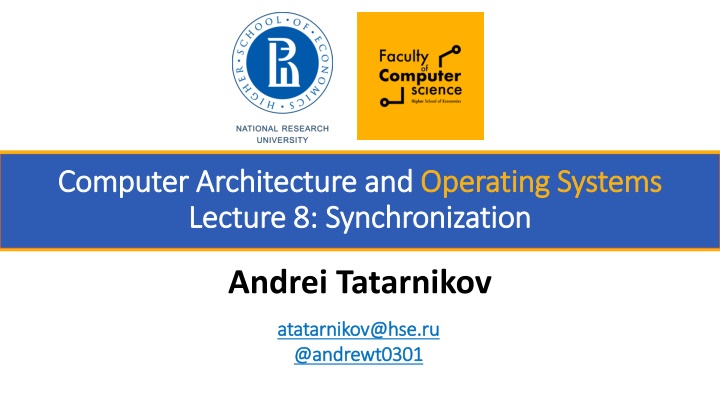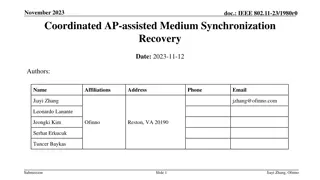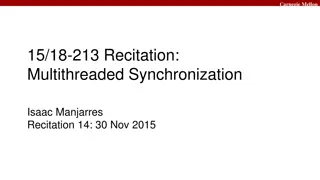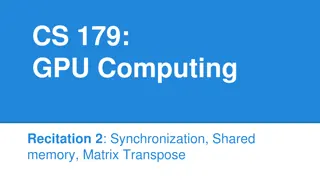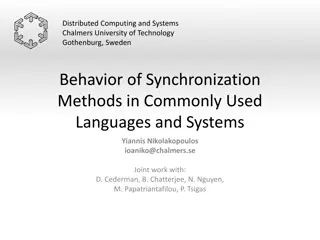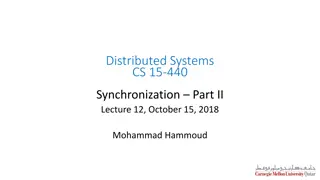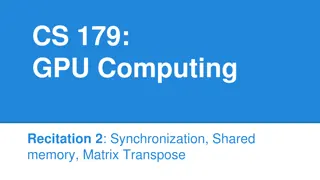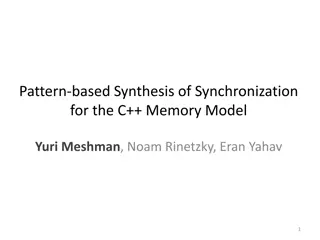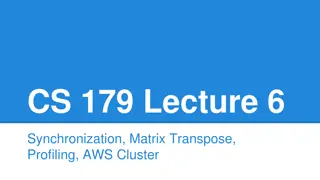Synchronization in Computer Architecture
Processes executing concurrently require synchronization to prevent data inconsistency. Learn about critical-section problems, solutions, and tools in computer architecture. Explore producer-consumer scenarios and race conditions.
Download Presentation

Please find below an Image/Link to download the presentation.
The content on the website is provided AS IS for your information and personal use only. It may not be sold, licensed, or shared on other websites without obtaining consent from the author.If you encounter any issues during the download, it is possible that the publisher has removed the file from their server.
You are allowed to download the files provided on this website for personal or commercial use, subject to the condition that they are used lawfully. All files are the property of their respective owners.
The content on the website is provided AS IS for your information and personal use only. It may not be sold, licensed, or shared on other websites without obtaining consent from the author.
E N D
Presentation Transcript
Computer Architecture Computer Architecture and Lecture Lecture 8 8: Synchronization and Operating Systems Operating Systems : Synchronization Andrei Tatarnikov atatarnikov@hse.ru atatarnikov@hse.ru @andrewt0301 @andrewt0301
Synchronization Tools Synchronization Tools Background The Critical-Section Problem Peterson s Solution Synchronization Hardware Mutex Locks Semaphores Monitors 2
Objectives Objectives To present the concept of process synchronization. To introduce the critical-section problem, whose solutions can be used to ensure the consistency of shared data To present both software and hardware solutions of the critical-section problem To examine several classical process-synchronization problems To explore several tools that are used to solve process synchronization problems 3
Background Background Processes can execute concurrently May be interrupted at any time, partially completing execution Concurrent access to shared data may result in data inconsistency Maintaining data consistency requires mechanisms to ensure the orderly execution of cooperating processes Illustration of the problem: Suppose that we wanted to provide a solution to the consumer-producer problem that fills all the buffers. We can do so by having an integer counter that keeps track of the number of full buffers. Initially, counter is set to 0. It is incremented by the producer after it produces a new buffer and is decremented by the consumer after it consumes a buffer. 4
Producer Producer while (true) { /* produce an item in next produced */ while (counter == BUFFER_SIZE) ; /* do nothing */ buffer[in] = next_produced; in = (in + 1) % BUFFER_SIZE; counter++; } 5
Consumer Consumer while (true) { while (counter == 0) ; /* do nothing */ next_consumed = buffer[out]; out = (out + 1) % BUFFER_SIZE; counter--; /* consume the item in next consumed */ } 6
Race Condition Race Condition counter++ could be implemented as register1 = counter register1 = register1 + 1 counter = register1 counter-- could be implemented as register2 = counter register2 = register2 - 1 counter = register2 Consider this execution interleaving with count = 5 initially: S0: producer execute register1 = counter S1: producer execute register1 = register1 + 1 {register1 = 6} S2: consumer execute register2 = counter S3: consumer execute register2 = register2 1 {register2 = 4} S4: producer execute counter = register1 {counter = 6 } S5: consumer execute counter = register2 {counter = 4} {register1 = 5} {register2 = 5} 7
Critical Section Problem Critical Section Problem Consider system of n processes {p0, p1, pn-1} Each process has critical section segment of code Process may be changing common variables, updating table, writing file, etc When one process in critical section, no other may be in its critical section Critical section problem is to design protocol to solve this Each process must ask permission to enter critical section in entry section, may follow critical section with exit section, then remainder section 8
Critical Section Critical Section General structure of process Pi 9
Algorithm for Process P Algorithm for Process Pi i do { while (turn == j); critical section turn = j; remainder section } while (true); 10
Solution to Critical Solution to Critical- -Section Problem Section Problem 1. Mutual Exclusion - If process Piis executing in its critical section, then no other processes can be executing in their critical sections 2. Progress - If no process is executing in its critical section and there exist some processes that wish to enter their critical section, then the selection of the processes that will enter the critical section next cannot be postponed indefinitely 3. Bounded Waiting - A bound must exist on the number of times that other processes are allowed to enter their critical sections after a process has made a request to enter its critical section and before that request is granted Assume that each process executes at a nonzero speed No assumption concerning relative speed of the n processes11
Critical Critical- -Section Handling in OS Section Handling in OS Two approaches depending on if kernel is preemptive or non- preemptive Preemptive allows preemption of process when running in kernel mode Non-preemptive runs until exits kernel mode, blocks, or voluntarily yields CPU Essentially free of race conditions in kernel mode 12
Peterson Peterson s s Solution Solution Good algorithmic description of solving the problem Two process solution Assume that the load and store machine-language instructions are atomic; that is, cannot be interrupted The two processes share two variables: int turn; Boolean flag[2] The variable turn indicates whose turn it is to enter the critical section The flag array is used to indicate if a process is ready to enter the critical section. flag[i] = true implies that process Piis ready! 13
Algorithm for Process P Algorithm for Process Pi i do { flag[i] = true; turn = j; while (flag[j] && turn = = j); critical section flag[i] = false; remainder section } while (true); 14
Peterson Peterson s Solution (Cont.) s Solution (Cont.) Provable that the three CS requirement are met: 1. Mutual exclusion is preserved Pi enters CS only if: either flag[j] = false or turn = i 2. Progress requirement is satisfied 3. Bounded-waiting requirement is met 15
Synchronization Hardware Synchronization Hardware Many systems provide hardware support for implementing the critical section code. All solutions below based on idea of locking Protecting critical regions via locks Uniprocessors could disable interrupts Currently running code would execute without preemption Generally too inefficient on multiprocessor systems Operating systems using this not broadly scalable Modern machines provide special atomic hardware instructions Atomic = non-interruptible Either test memory word and set value Or swap contents of two memory words 16
Solution to Critical Solution to Critical- -section Problem Using Locks section Problem Using Locks do { acquire lock critical section release lock remainder section } while (TRUE); 17
test_and_set test_and_set Instruction Instruction Definition: boolean test_and_set (boolean *target) { boolean rv = *target; *target = TRUE; return rv: } 1.Executed atomically 2.Returns the original value of passed parameter 3.Set the new value of passed parameter to TRUE . 18
Solution using Solution using test_and_set test_and_set() () Shared Boolean variable lock, initialized to FALSE Solution: do { while (test_and_set(&lock)) ; /* do nothing */ /* critical section */ lock = false; /* remainder section */ } while (true); 19
compare_and_swap compare_and_swap Instruction Instruction Definition: int compare _and_swap(int *value, int expected, int new_value) { int temp = *value; if (*value == expected) *value = new_value; return temp; } 1.Executed atomically 2.Returns the original value of passed parameter value 3.Set the variable value the value of the passed parameter new_value but only if value == expected . That is, the swap takes place only under this condition. 20
Solution using Solution using compare_and_swap compare_and_swap Shared integer lock initialized to 0; Solution: do { while (compare_and_swap(&lock, 0, 1) != 0) ; /* do nothing */ /* critical section */ lock = 0; /* remainder section */ } while (true); 21
Bounded Bounded- -waiting Mutual Exclusion with waiting Mutual Exclusion with test_and_set test_and_set do { waiting[i] = true; key = true; while (waiting[i] && key) key = test_and_set(&lock); waiting[i] = false; /* critical section */ j = (i + 1) % n; while ((j != i) && !waiting[j]) j = (j + 1) % n; if (j == i) lock = false; else waiting[j] = false; /* remainder section */ } while (true); 22
Mutex Mutex Locks Locks Previous solutions are complicated and generally inaccessible to application programmers OS designers build software tools to solve critical section problem Simplest is mutex lock Protect a critical section by first acquire()a lock then release()the lock Boolean variable indicating if lock is available or not Calls to acquire()and release()must be atomic Usually implemented via hardware atomic instructions But this solution requires busy waiting This lock therefore called a spinlock 23
acquire() and release() acquire() and release() acquire() { while (!available) ; /* busy wait */ available = false; } release() { available = true; } do { acquire lock critical section release lock remainder section } while (true); 24
Semaphore Semaphore Synchronization tool that provides more sophisticated ways (than Mutex locks) for process to synchronize their activities. Semaphore S integer variable Can only be accessed via two indivisible (atomic) operations wait() and signal() Originally called P() and V() Definition of the wait() operation wait(S) { while (S <= 0) ; // busy wait S--; } Definition of the signal() operation signal(S) { S++; } 25
Semaphore Usage Semaphore Usage Counting semaphore integer value can range over an unrestricted domain Binary semaphore integer value can range only between 0 and 1 Same as a mutex lock Can solve various synchronization problems Consider P1and P2that require S1to happen before S2 Create a semaphore synch initialized to 0 P1: S1; signal(synch); P2: wait(synch); S2; Can implement a counting semaphore S as a binary semaphore 26
Semaphore Implementation Semaphore Implementation Must guarantee that no two processes can execute the wait() and signal() on the same semaphore at the same time Thus, the implementation becomes the critical section problem where the wait and signal code are placed in the critical section Could now have busy waiting in critical section implementation But implementation code is short Little busy waiting if critical section rarely occupied Note that applications may spend lots of time in critical sections and therefore this is not a good solution 27
Semaphore Implementation with no Busy waiting Semaphore Implementation with no Busy waiting With each semaphore there is an associated waiting queue Each entry in a waiting queue has two data items: value (of type integer) pointer to next record in the list Two operations: block place the process invoking the operation on the appropriate waiting queue wakeup remove one of processes in the waiting queue and place it in the ready queue typedef struct{ int value; struct process *list; } semaphore; 28
Implementation with no Busy waiting (Cont.) Implementation with no Busy waiting (Cont.) wait(semaphore *S) { S->value--; if (S->value < 0) { add this process to S->list; block(); } } signal(semaphore *S) { S->value++; if (S->value <= 0) { remove a process P from S->list; wakeup(P); } } 29
Deadlock and Starvation Deadlock and Starvation Deadlock two or more processes are waiting indefinitely for an event that can be caused by only one of the waiting processes Let S and Q be two semaphores initialized to 1 P0 P1 wait(S); wait(Q); wait(Q); wait(S); ... ... signal(S); signal(Q); signal(Q); signal(S); Starvation indefinite blocking A process may never be removed from the semaphore queue in which it is suspended Priority Inversion Scheduling problem when lower-priority process holds a lock needed by higher-priority process Solved via priority-inheritance protocol 30
Problems with Semaphores Problems with Semaphores Incorrect use of semaphore operations: signal (mutex) . wait (mutex) wait (mutex) wait (mutex) Omitting of wait (mutex) or signal (mutex) (or both) Deadlock and starvation are possible. 31
Monitors Monitors A high-level abstraction that provides a convenient and effective mechanism for process synchronization Abstract data type, internal variables only accessible by code within the procedure Only one process may be active within the monitor at a time But not powerful enough to model some synchronization schemes monitor monitor-name { // shared variable declarations procedure P1 ( ) { . } procedure Pn ( ) { } Initialization code ( ) { } } } 32
Schematic view of a Monitor Schematic view of a Monitor 33
Condition Variables Condition Variables x, y; condition Two operations are allowed on a condition variable: x.wait() a process that invokes the operation is suspended until x.signal() x.signal() resumes one of processes (if any) that invoked x.wait() If no x.wait()on the variable, then it has no effect on the variable 34
Monitor with Condition Variables Monitor with Condition Variables 35
Condition Variables Choices Condition Variables Choices If process P invokes x.signal(),andprocess Q is suspended in x.wait(), what should happen next? Both Q and P cannot execute in paralel. If Q is resumed, then P must wait Options include Signal and wait P waits until Q either leaves the monitor or it waits for another condition Signal and continue Q waits until P either leaves the monitor or it waits for another condition Both have pros and cons language implementer can decide Monitors implemented in Concurrent Pascal compromise P executing signal immediately leaves the monitor, Q is resumed Implemented in other languages including Mesa, C#, Java 36
Monitor Implementation Using Semaphores Monitor Implementation Using Semaphores Variables semaphore mutex; // (initially = 1) semaphore next; // (initially = 0) int next_count = 0; Each procedure F will be replaced by wait(mutex); body of F; if (next_count > 0) signal(next) else signal(mutex); Mutual exclusion within a monitor is ensured 37
Monitor Implementation Monitor Implementation Condition Variables For each condition variable x, we have: semaphore x_sem; // (initially = 0) int x_count = 0; Condition Variables The operation x.wait can be implemented as: x_count++; if (next_count > 0) signal(next); else signal(mutex); wait(x_sem); x_count--; 38
Monitor Implementation (Cont.) Monitor Implementation (Cont.) The operation x.signal can be implemented as: if (x_count > 0) { next_count++; signal(x_sem); wait(next); next_count--; } 39
Resuming Processes within a Monitor Resuming Processes within a Monitor If several processes queued on condition x, and x.signal() executed, which should be resumed? FCFS frequently not adequate conditional-wait construct of the form x.wait(c) Where c is priority number Process with lowest number (highest priority) is scheduled next 40
Single Resource Allocation Allocate a single resource among competing processes using priority numbers that specify the maximum time a process plans to use the resource R.acquire(t); ... access the resurce; ... R.release; Where R is an instance of type ResourceAllocator 41
A Monitor to Allocate Single Resource A Monitor to Allocate Single Resource monitor ResourceAllocator { boolean busy; condition x; void acquire(int time) { if (busy) x.wait(time); busy = TRUE; } void release() { busy = FALSE; x.signal(); } initialization code() { busy = FALSE; } } 42
Any Questions? Any Questions? 43
